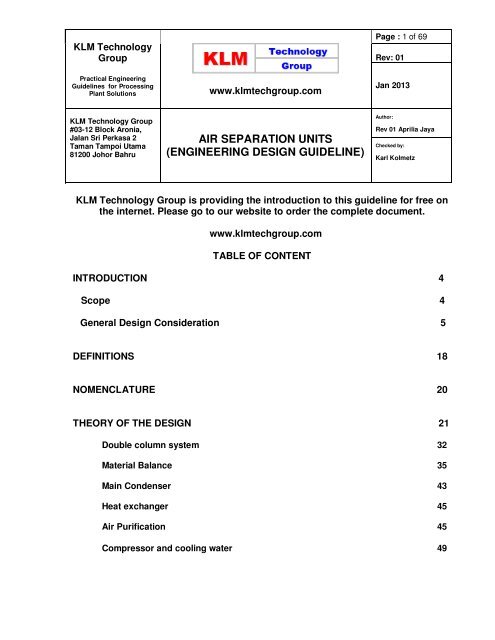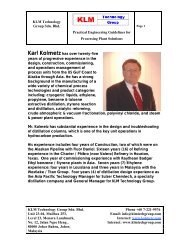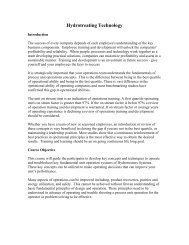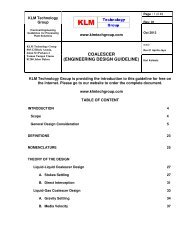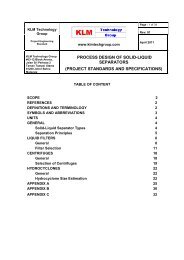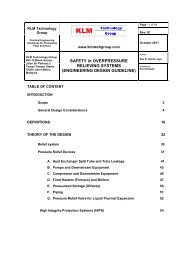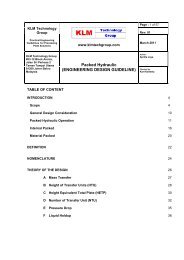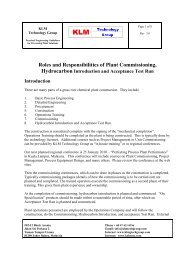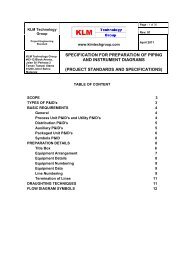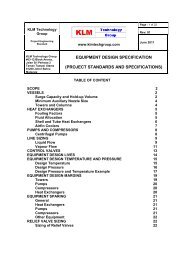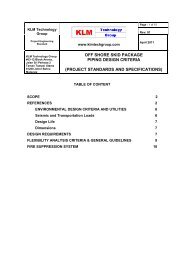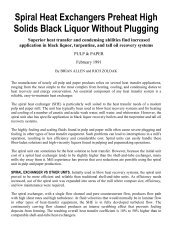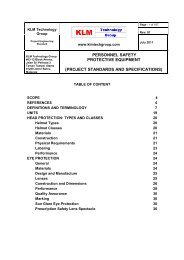air separation units (engineering design guideline) - KLM ...
air separation units (engineering design guideline) - KLM ...
air separation units (engineering design guideline) - KLM ...
Create successful ePaper yourself
Turn your PDF publications into a flip-book with our unique Google optimized e-Paper software.
<strong>KLM</strong> TechnologyGroupPractical EngineeringGuidelines for Processing PlantSolutionsAIR SEPARATION UNITS(ENGINEERING DESIGN GUIDELINES)Page 4 of 69Rev: 01Jan 2013<strong>KLM</strong> Technology Group is providing the introduction to this <strong>guideline</strong> for free onthe internet. Please go to our website to order the complete document.www.klmtechgroup.comINTRODUCTIONScopeThis <strong>design</strong> <strong>guideline</strong> covers the basic elements of <strong>air</strong> <strong>separation</strong> <strong>units</strong> in sufficientdetail to allow an engineer to <strong>design</strong> an <strong>air</strong> <strong>separation</strong> <strong>units</strong> with the suitable size of wallthickness, reflux ratio, actual stages, heat duties of a reboiler and a condenser, andpermissible pressures.For <strong>air</strong> <strong>separation</strong>, as with any process equipment, successful sizing and selection isalways a combination of empirical observation/experience and analytical modeling. The<strong>air</strong> <strong>separation</strong> process requires a very tight integration of heat exchangers and<strong>separation</strong> columns to obtain a good efficiency and all the energy for refrigeration isprovided by the compression of the <strong>air</strong> at the inlet of the unit. There are severalmethods to separate the <strong>air</strong> such as Cryogenic Distillation, Membrane, Pressure SwingAdsorption (PSA) and Vacuum Pressure Swing Adsorption (VPSA)The <strong>design</strong> of <strong>air</strong> <strong>separation</strong> may be influenced by factors, including processrequirements, economics and safety. In the <strong>design</strong> section, there are tables that assistin making these factored calculations from the vary reference sources. Include in this<strong>guideline</strong> is a calculation spreadsheet for the <strong>engineering</strong> <strong>design</strong>. .All the importantparameters use in the <strong>guideline</strong> are explained in the definition section which help thereader more understand the meaning of the parameters or the term used.The theory section explains the material balance in cryogenic distillation, how tocalculate the <strong>air</strong> <strong>separation</strong> requirements, and the equipment which is influenced in <strong>air</strong><strong>separation</strong> system. The application of the <strong>air</strong> <strong>separation</strong> theory with the example willmake the engineer understand the <strong>air</strong> <strong>separation</strong> process and be ready to perform theactual <strong>design</strong> of the <strong>air</strong> <strong>separation</strong>.These <strong>design</strong> <strong>guideline</strong> are believed to be as accurate as possible, but are very general and not for specific <strong>design</strong>cases. They were <strong>design</strong>ed for engineers to do preliminary <strong>design</strong>s and process specification sheets. The final<strong>design</strong> must always be guaranteed for the service selected by the manufacturing vendor, but these <strong>guideline</strong>s willgreatly reduce the amount of up front <strong>engineering</strong> hours that are required to develop the final <strong>design</strong>. The <strong>guideline</strong>sare a training tool for young engineers or a resource for engineers with experience.This document is entrusted to the recipient personally, but the copyright remains with us. It must not be copied,reproduced or in any way communicated or made accessible to third parties without our written consent.
<strong>KLM</strong> TechnologyGroupPractical EngineeringGuidelines for Processing PlantSolutionsAIR SEPARATION UNITS(ENGINEERING DESIGN GUIDELINES)Page 6 of 69Rev: 01Jan 2013Membrane SeparationMembrane <strong>separation</strong> isolates nitrogen from atmospheric <strong>air</strong> by selective permeationacross a membrane wall. The membrane used in this method consists of a bundle ofselectively permeable hollow fibers. These fibers allow the “fast” gases (oxygen, carbondioxide and water vapor) to permeate the membrane wall much faster than the “slow”gas (nitrogen).The membrane separates the original gas mixture into two streams. One stream, calledthe permeate, contains oxygen, carbon dioxide and water vapor. The other stream,called the product, consists of high-pressure nitrogen. The permeate is vented to theatmosphere and the product, nitrogen, exits the downstream end of the membrane fordelivery to the end-user or to a booster if further compression is required.The purity of the product can be adjusted by changing the operation conditions. If thenitrogen flow rate is decreased, nitrogen purity increases and conversely, by increasingnitrogen flow, nitrogen purity is decreased. A flow/purity control valve at the dischargeend of the nitrogen stream, downstream of the flow meter and nitrogen analyzer, allowsfinite control of flow and therefore purity.The advantages:1. Most economical process at low flow rates (up to 40,000 SCFH)2. Simplest process in terms of calculators and <strong>engineering</strong> <strong>design</strong>3. Least costly for rep<strong>air</strong>s and maintenance.4. Lowest tax and insurance5. Requires the least amount of equipment for start-upThe disadvantage: Nitrogen purity is not good enough for certain process where theremust be 1 part per billion purity.These <strong>design</strong> <strong>guideline</strong> are believed to be as accurate as possible, but are very general and not for specific <strong>design</strong>cases. They were <strong>design</strong>ed for engineers to do preliminary <strong>design</strong>s and process specification sheets. The final<strong>design</strong> must always be guaranteed for the service selected by the manufacturing vendor, but these <strong>guideline</strong>s willgreatly reduce the amount of up front <strong>engineering</strong> hours that are required to develop the final <strong>design</strong>. The <strong>guideline</strong>sare a training tool for young engineers or a resource for engineers with experience.This document is entrusted to the recipient personally, but the copyright remains with us. It must not be copied,reproduced or in any way communicated or made accessible to third parties without our written consent.
<strong>KLM</strong> TechnologyGroupPractical EngineeringGuidelines for Processing PlantSolutionsAIR SEPARATION UNITS(ENGINEERING DESIGN GUIDELINES)Page 7 of 69Rev: 01Jan 2013PermeatedFigure 1: Membrane <strong>separation</strong>These <strong>design</strong> <strong>guideline</strong> are believed to be as accurate as possible, but are very general and not for specific <strong>design</strong>cases. They were <strong>design</strong>ed for engineers to do preliminary <strong>design</strong>s and process specification sheets. The final<strong>design</strong> must always be guaranteed for the service selected by the manufacturing vendor, but these <strong>guideline</strong>s willgreatly reduce the amount of up front <strong>engineering</strong> hours that are required to develop the final <strong>design</strong>. The <strong>guideline</strong>sare a training tool for young engineers or a resource for engineers with experience.This document is entrusted to the recipient personally, but the copyright remains with us. It must not be copied,reproduced or in any way communicated or made accessible to third parties without our written consent.
<strong>KLM</strong> TechnologyGroupPractical EngineeringGuidelines for Processing PlantSolutionsAIR SEPARATION UNITS(ENGINEERING DESIGN GUIDELINES)Page 8 of 69Rev: 01Jan 2013Pressure Swing Adsorption (PSA)Pressure swing adsorption (PSA) is a technology used to separate some gas speciesfrom a mixture of gases under pressure according to the species' molecularcharacteristics and affinity for an adsorbent material. It operates at near-ambienttemperatures and so differs from cryogenic distillation techniques of gas <strong>separation</strong>.Special adsorptive materials (e.g., zeolites) are used as a molecular sieve, preferentiallyadsorbing the target gas species at high pressure. The process then swings to lowpressure to desorb the adsorbent material.Pressure swing adsorption processes rely on the fact that under high pressure, gasestend to be attracted to solid surfaces, or "adsorbed". The higher the pressure, the moregas is adsorbed; when the pressure is reduced, the gas is released, or desorbed. PSAprocesses can be used to separate gases in a mixture because different gases tend tobe attracted to different solid surfaces more or less strongly.If a gas mixture such as <strong>air</strong>, for example, is passed under pressure through a vesselcontaining an adsorbent bed of zeolite that attracts nitrogen more strongly than it doesoxygen, part or all of the nitrogen will stay in the bed, and the gas coming out of thevessel will be enriched in oxygen. When the bed reaches the end of its capacity toadsorb nitrogen, it can be regenerated by reducing the pressure, thereby releasing theadsorbed nitrogen. It is then ready for another cycle of producing oxygen enriched <strong>air</strong>.This is exactly the process used in portable oxygen concentrators used by emphysemapatients and others who require oxygen enriched <strong>air</strong> to breathe.Using two adsorbent vessels allows near-continuous production of the target gas. It alsopermits so-called pressure equalization, where the gas leaving the vessel beingdepressured is used to partially pressurize the second vessel. This results in significantenergy savings, and is common industrial practice.Aside from their ability to discriminate between different gases, adsorbents for PSAsystems are usually very porous materials chosen because of their large surface areas.Typical adsorbents are activated carbon, silica gel, alumina and zeolite. Though the gasadsorbed on these surfaces may consist of a layer only one or at most a few moleculesthick, surface areas of several hundred square meters per gram enable the adsorptionof a significant portion of the adsorbent's weight in gas. In addition to their selectivity fordifferent gases, zeolites and some types of activated carbon called carbon molecularThese <strong>design</strong> <strong>guideline</strong> are believed to be as accurate as possible, but are very general and not for specific <strong>design</strong>cases. They were <strong>design</strong>ed for engineers to do preliminary <strong>design</strong>s and process specification sheets. The final<strong>design</strong> must always be guaranteed for the service selected by the manufacturing vendor, but these <strong>guideline</strong>s willgreatly reduce the amount of up front <strong>engineering</strong> hours that are required to develop the final <strong>design</strong>. The <strong>guideline</strong>sare a training tool for young engineers or a resource for engineers with experience.This document is entrusted to the recipient personally, but the copyright remains with us. It must not be copied,reproduced or in any way communicated or made accessible to third parties without our written consent.
<strong>KLM</strong> TechnologyGroupPractical EngineeringGuidelines for Processing PlantSolutionsAIR SEPARATION UNITS(ENGINEERING DESIGN GUIDELINES)Page 9 of 69Rev: 01Jan 2013sieves may utilize their molecular sieve characteristics to exclude some gas moleculesfrom their structure based on the size of the molecules, thereby restricting the ability ofthe larger molecules to be adsorbed.One of the primary applications of PSA is in the removal of carbon dioxide (CO 2 ) as thefinal step in the large-scale commercial synthesis of hydrogen (H 2 ) for use in oilrefineries and in the production of ammonia (NH 3 ). Refineries often use PSA technologyin the removal of hydrogen sulfide (H 2 S) from hydrogen feed and recycle streams ofhydrotreating and hydrocracking <strong>units</strong>.Another application of PSA is the <strong>separation</strong> of carbon dioxide from biogas to increasethe methane (CH 4 ) content. Through PSA the biogas can be upgraded to a qualitysimilar to natural gas. Nitrogen generator <strong>units</strong> employ the PSA technique to producehigh purity nitrogen gas (99.5% or greater) from a supply of compressed <strong>air</strong>.PSA is an economic choice for small-scale production of reasonable purity oxygen ornitrogen from <strong>air</strong>. PSA technology has a major use in the medical industry to produceoxygen, particularly in remote or inaccessible parts of the world where bulk cryogenic orcompressed cylinder storage is not possible. PSA is also used in hypoxic <strong>air</strong> fireprevention systems to produce <strong>air</strong> with a low oxygen content. PSA is also used in an onpurpose propylene plant via propane dehydrogenation. It consists of a selective mediafor the preferred adsorption of methane and ethane over hydrogen.The advantages1. PSA <strong>units</strong> can be placed on-site which makes the N 2 readily available as needed2. It the amount of N 2 needed is less than 20,000 SCFH, the using PSA unit is moreeconomical than a cryogenic process.3. During shutdown, less money is lost than would be in a cryogenic process4. PSA unit are readily available and can be purchased and delivered quicklyThe disadvantages1. If the flow rate is increased to 40,000 SCFH, then it becomes significantly cheaper tobuy N 2 from a cryogenic source.2. There is possible down time with respect to the compressor that is being used3. Extremely noisy even when compared with the other process.These <strong>design</strong> <strong>guideline</strong> are believed to be as accurate as possible, but are very general and not for specific <strong>design</strong>cases. They were <strong>design</strong>ed for engineers to do preliminary <strong>design</strong>s and process specification sheets. The final<strong>design</strong> must always be guaranteed for the service selected by the manufacturing vendor, but these <strong>guideline</strong>s willgreatly reduce the amount of up front <strong>engineering</strong> hours that are required to develop the final <strong>design</strong>. The <strong>guideline</strong>sare a training tool for young engineers or a resource for engineers with experience.This document is entrusted to the recipient personally, but the copyright remains with us. It must not be copied,reproduced or in any way communicated or made accessible to third parties without our written consent.
<strong>KLM</strong> TechnologyGroupPractical EngineeringGuidelines for Processing PlantSolutionsAIR SEPARATION UNITS(ENGINEERING DESIGN GUIDELINES)Page 10 of 69Rev: 01Jan 2013Figure 2: Pressure Swing Adsorption (PSA)These <strong>design</strong> <strong>guideline</strong> are believed to be as accurate as possible, but are very general and not for specific <strong>design</strong>cases. They were <strong>design</strong>ed for engineers to do preliminary <strong>design</strong>s and process specification sheets. The final<strong>design</strong> must always be guaranteed for the service selected by the manufacturing vendor, but these <strong>guideline</strong>s willgreatly reduce the amount of up front <strong>engineering</strong> hours that are required to develop the final <strong>design</strong>. The <strong>guideline</strong>sare a training tool for young engineers or a resource for engineers with experience.This document is entrusted to the recipient personally, but the copyright remains with us. It must not be copied,reproduced or in any way communicated or made accessible to third parties without our written consent.
<strong>KLM</strong> TechnologyGroupPractical EngineeringGuidelines for Processing PlantSolutionsAIR SEPARATION UNITS(ENGINEERING DESIGN GUIDELINES)Page 11 of 69Rev: 01Jan 2013Vacuum Pressure Swing Adsorption (VPSA)The Vacuum Pressures Swing Adsorption (VPSA) process is a variation on thePressures Swing Adsorption (PSA) process, which is more applicable forcertain applications. VPSA uses a feed blower instead of an <strong>air</strong> compressor to supply<strong>air</strong> to the system and the purified gas is collected using a vacuum blower to desorb theadsorber vessels. The use of different technology in VPSA results in a significantdecrease in the power consumption of the system. Although power savings are clearwith this system, they are typically cost effective only for plants requiring very largeoxygen producing capacities.Each VPSA system includes a rotary-lobe feed <strong>air</strong> blower, vacuum blower (two bedsystems only), one or two adsorbent vessels, an oxygen surge tank, switching valvesand computer controls.In the single-bed system, the blower draws in <strong>air</strong>, compresses it and sends it to theadsorbent vessel to remove impurities, leaving 90 to 94 percent pure oxygen as theproduct. The adsorbent is then regenerated as the blower removes gas by reducing thepressure inside the vessel. The waste gas (nitrogen, water and carbon dioxide) is thendischarged into the <strong>air</strong>. Since oxygen is not produced during regeneration, the systemincludes a low-pressure surge tank to allow for continuous oxygen supply.The two-bed system uses a similar adsorption process cycle that relies on swings inpressure -- from above one atmosphere to below atmospheric pressure (vacuum) -- tocycle each bed sequentially from adsorption to desorption.One bed is always adsorbing impurities to separate oxygen from <strong>air</strong>, while the other bedregenerates. Thus, the beds alternately produce oxygen into a surge tank whichensures that product is available continuously at a consistent pressure and purity.Comparison of VPSA with PSA and cryogenic <strong>separation</strong>1. Though VPSA systems are more costly to build, they are comparatively moreenergy efficient than PSA systems for the same product flow, pressure and purityconditions.2. Oxygen VPSA <strong>units</strong> are economical than oxygen PSA <strong>units</strong> only when the desiredproduction rate is greater than about 20 tons per day, up to 60 tons per day ormore.These <strong>design</strong> <strong>guideline</strong> are believed to be as accurate as possible, but are very general and not for specific <strong>design</strong>cases. They were <strong>design</strong>ed for engineers to do preliminary <strong>design</strong>s and process specification sheets. The final<strong>design</strong> must always be guaranteed for the service selected by the manufacturing vendor, but these <strong>guideline</strong>s willgreatly reduce the amount of up front <strong>engineering</strong> hours that are required to develop the final <strong>design</strong>. The <strong>guideline</strong>sare a training tool for young engineers or a resource for engineers with experience.This document is entrusted to the recipient personally, but the copyright remains with us. It must not be copied,reproduced or in any way communicated or made accessible to third parties without our written consent.
<strong>KLM</strong> TechnologyGroupPractical EngineeringGuidelines for Processing PlantSolutionsAIR SEPARATION UNITS(ENGINEERING DESIGN GUIDELINES)Page 12 of 69Rev: 01Jan 20133. They are more preferred in those cases when providing high purity oxygen is notrequired. · Cryogenic plants are preferred production rate is 60 tons or above perday.4. However, two oxygen VPSA plants can also perform in the same manner whenthey allow for better matching of large step-changes in demand.5. PSA specific power is approximately 1/3rd less than that for oxygen PSA plants, butalmost same to the specific power of cryogenic <strong>air</strong> <strong>separation</strong> <strong>units</strong>.Figure 3: Vacuum Pressure Swing Adsorption (VPSA). (ranacaregroup.com)These <strong>design</strong> <strong>guideline</strong> are believed to be as accurate as possible, but are very general and not for specific <strong>design</strong>cases. They were <strong>design</strong>ed for engineers to do preliminary <strong>design</strong>s and process specification sheets. The final<strong>design</strong> must always be guaranteed for the service selected by the manufacturing vendor, but these <strong>guideline</strong>s willgreatly reduce the amount of up front <strong>engineering</strong> hours that are required to develop the final <strong>design</strong>. The <strong>guideline</strong>sare a training tool for young engineers or a resource for engineers with experience.This document is entrusted to the recipient personally, but the copyright remains with us. It must not be copied,reproduced or in any way communicated or made accessible to third parties without our written consent.
<strong>KLM</strong> TechnologyGroupPractical EngineeringGuidelines for Processing PlantSolutionsAIR SEPARATION UNITS(ENGINEERING DESIGN GUIDELINES)Page 13 of 69Rev: 01Jan 2013Cryogenic distillationProduction of high purity oxygen, nitrogen, and argon as used for Semiconductor devicefabrication requires cryogenic distillation. Similarly, the only viable sources of the raregases neon, krypton, and xenon is the distillation of <strong>air</strong> using at least two distillationcolumns. Cryogenic ASU's are built to provide nitrogen and/or oxygen and often coproduceargon where liquid products (Liquid nitrogen "LIN", Liquid oxygen "LOX", andLiquid argon "LAR") and gases product (Gaseous oxygen “GOX” and Gaseous nitrogen“GAN”) can only be produced if sufficient refrigeration is provided for in the <strong>design</strong>.Below are the main process functions from figure 4 below1. Air compressor with filter. Dust free <strong>air</strong> is compressed tp a pressure sufficient toget it through the equipment.2. Air purifying. Mole sieves are used to remove water vapor, carbon dioxide andcertain other contaminants.3. Cooling down the <strong>air</strong>. In a heat exchanger the <strong>air</strong> is cooled down close to the dewpoint by the cold separated gases, which come from the distillation column. If asuitably large enough heat exchanger is used the cold gases can be warmed to atemperature just under that of the incoming <strong>air</strong>, so that the cold losses becomeacceptable.4. Cold production. Production of liquid products requires cold and cold losses occurthrough the equipment insulation and in the heat exchanger. this cold is produced ina recycle because the gas which does not condense is warmed up and is fed backto the compressor again.5. Cooling with cooling water. Compressors and other machines need largeamounts of cooling water. A large part of the heat removal is in fact cold production.6. Air <strong>separation</strong>. The liquid is separated into oxygen, argon, and nitrogen in thedistillation columns. The cold gases are fed through the heat exchanger and arewarmed-up while the liquids are fed into tank.7. Coldbox. The cold equipments demand much insulation order to get an acceptablecold loss. So columns, heat exchangers and parts of the cold production equipmentare built in a large tower like box, the so-called coldbox.These <strong>design</strong> <strong>guideline</strong> are believed to be as accurate as possible, but are very general and not for specific <strong>design</strong>cases. They were <strong>design</strong>ed for engineers to do preliminary <strong>design</strong>s and process specification sheets. The final<strong>design</strong> must always be guaranteed for the service selected by the manufacturing vendor, but these <strong>guideline</strong>s willgreatly reduce the amount of up front <strong>engineering</strong> hours that are required to develop the final <strong>design</strong>. The <strong>guideline</strong>sare a training tool for young engineers or a resource for engineers with experience.This document is entrusted to the recipient personally, but the copyright remains with us. It must not be copied,reproduced or in any way communicated or made accessible to third parties without our written consent.
<strong>KLM</strong> TechnologyGroupPractical EngineeringGuidelines for Processing PlantSolutionsAIR SEPARATION UNITS(ENGINEERING DESIGN GUIDELINES)Page 14 of 69Rev: 01Jan 2013AirElectricalpowerCoolingwaterColdproductionDistillationcolumnLINAirCompressorwith filterPurificationwith molesievesHeatexchangerGANAirGOXLINLOXLARElectricalpowerColdboxFigure 4: Original <strong>air</strong> <strong>separation</strong> processThese <strong>design</strong> <strong>guideline</strong> are believed to be as accurate as possible, but are very general and not for specific <strong>design</strong>cases. They were <strong>design</strong>ed for engineers to do preliminary <strong>design</strong>s and process specification sheets. The final<strong>design</strong> must always be guaranteed for the service selected by the manufacturing vendor, but these <strong>guideline</strong>s willgreatly reduce the amount of up front <strong>engineering</strong> hours that are required to develop the final <strong>design</strong>. The <strong>guideline</strong>sare a training tool for young engineers or a resource for engineers with experience.This document is entrusted to the recipient personally, but the copyright remains with us. It must not be copied,reproduced or in any way communicated or made accessible to third parties without our written consent.
<strong>KLM</strong> TechnologyGroupPractical EngineeringGuidelines for Processing PlantSolutionsAIR SEPARATION UNITS(ENGINEERING DESIGN GUIDELINES)Page 15 of 69Rev: 01Jan 2013To achieve the low distillation temperatures an Air Separation Unit (ASU) requires arefrigeration cycle that operates by means of the Joule–Thomson effect, and the coldequipment has to be kept within an insulated enclosure (commonly called a "cold box").The cooling of the gases requires a large amount of energy to make this refrigerationcycle work and is delivered by an <strong>air</strong> compressor. The process consists of the followingmain steps.Before compression the <strong>air</strong> is pre-filtered of dust. Air is compressed where the finaldelivery pressure is determined by recoveries and the fluid state (gas or liquid) of theproducts. Typical pressures range between 5 and 10 bar gauge. The <strong>air</strong> stream mayalso be compressed to different pressures to enhance the efficiency of the ASU. Duringcompression water is condensed out in inter-stage coolers.The process <strong>air</strong> is generally passed through a molecular sieve bed, which removes anyremaining water vapor, as well as carbon dioxide, which would freeze and plug thecryogenic equipment. Molecular sieves are often <strong>design</strong>ed to remove any gaseoushydrocarbons from the <strong>air</strong>, since these can be a problem in the subsequent <strong>air</strong>distillation that could lead to explosions. The molecular sieves bed must beregenerated. This is done by installing multiple <strong>units</strong> operating in alternating mode andusing the dry co-produced waste gas to desorbs the water.Process <strong>air</strong> is passed through an integrated heat exchanger (usually a plate fin heatexchanger) and cooled against product (and waste) cryogenic streams. Part of the <strong>air</strong>liquefies to form a liquid that is enriched in oxygen. The remaining gas is richer innitrogen and is distilled to almost pure nitrogen (typically < 1ppm) in a high pressure(HP) distillation column. The condenser of this column requires refrigeration which isobtained from expanding the more oxygen rich stream further across a valve or throughan Expander, (a reverse compressor).Alternatively the condenser may be cooled by interchanging heat with a reboiler in a lowpressure (LP) distillation column (operating at 1.2-1.3 bar abs.) when the ASU isproducing pure oxygen. To minimize the compression cost the combinedcondenser/reboiler of the HP/LP columns must operate with a temperature difference ofonly 1-2 degrees Kelvin, requiring plate fin brazed aluminum heat exchangers. Typicaloxygen purities range in from 97.5% to 99.5% and influence the maximum recovery ofoxygen. The refrigeration required for producing liquid products is obtained using the JTeffect in an expander which feeds compressed <strong>air</strong> directly to the low pressure column.Hence, a certain part of the <strong>air</strong> is not to be separated and must leave the low pressurecolumn as a waste stream from its upper section.These <strong>design</strong> <strong>guideline</strong> are believed to be as accurate as possible, but are very general and not for specific <strong>design</strong>cases. They were <strong>design</strong>ed for engineers to do preliminary <strong>design</strong>s and process specification sheets. The final<strong>design</strong> must always be guaranteed for the service selected by the manufacturing vendor, but these <strong>guideline</strong>s willgreatly reduce the amount of up front <strong>engineering</strong> hours that are required to develop the final <strong>design</strong>. The <strong>guideline</strong>sare a training tool for young engineers or a resource for engineers with experience.This document is entrusted to the recipient personally, but the copyright remains with us. It must not be copied,reproduced or in any way communicated or made accessible to third parties without our written consent.
<strong>KLM</strong> TechnologyGroupPractical EngineeringGuidelines for Processing PlantSolutionsAIR SEPARATION UNITS(ENGINEERING DESIGN GUIDELINES)Page 16 of 69Rev: 01Jan 2013Because the boiling point of argon (87.3 K at standard conditions) lies between that ofoxygen (90.2 K) and nitrogen (77.4 K), argon builds up in the lower section of the lowpressure column. When argon is produced, a vapor side draw is taken from the lowpressure column where the argon concentration is highest. It is sent to another columnrectifying the argon to the desired purity from which liquid is returned to the samelocation in the LP column. Use of modern structured packings which have very lowpressure drops enable argon purities of less than 1 ppm. Though argon is present inless to 1% of the incoming, the <strong>air</strong> argon column requires a significant amount of energydue to the high reflux ratio required (about 30) in the argon column. Cooling of the argoncolumn can be supplied from cold expanded rich liquid or by liquid nitrogen.Finally the products produced in gas form are warmed against the incoming <strong>air</strong> toambient temperatures. This requires a carefully crafted heat integration that must allowfor robustness against disturbances (due to switch over of the molecular sieve beds[8]).It may also require additional external refrigeration during start-up. The <strong>air</strong> gases aresometimes supplied by pipeline to large industrial users adjacent to or nearby to theproduction plant. Unless a viable pipeline system exists, long distance transportation ofproducts is usually done as a liquid product for large quantities or as dewar flasks orgas cylinders for small quantities.The unique feature of <strong>air</strong> <strong>separation</strong> is the great interdependency of the different flows.This is because it is cryogenic process, in which the external media such as coolingwater and steam cannot be used. The different products or internal flows are used forboiling and condensing in the column, as reflux, for cooling the incoming <strong>air</strong> and forsubcooling the liquid products. For example, cold nitrogen gas is used in the recycle forcold production for liquid faction. A changed gas flow gives the different pressure, and achange of pressure can have a considerable effect on the other flows as their boilingpoints change with the pressure also changed temperature.The advantage:1. Cryogenic can produce large quantities of high purity of nitrogen.2. Some process like the humid <strong>air</strong> expansion process have a yield of about 40 – 60%pr pass which allows to produce large quantities of nitrogen efficiently.3. Cryogenic process do not have economics scale such as expansion or reduction ofproduct quantity requirements generally does not necessitate new equipment.These <strong>design</strong> <strong>guideline</strong> are believed to be as accurate as possible, but are very general and not for specific <strong>design</strong>cases. They were <strong>design</strong>ed for engineers to do preliminary <strong>design</strong>s and process specification sheets. The final<strong>design</strong> must always be guaranteed for the service selected by the manufacturing vendor, but these <strong>guideline</strong>s willgreatly reduce the amount of up front <strong>engineering</strong> hours that are required to develop the final <strong>design</strong>. The <strong>guideline</strong>sare a training tool for young engineers or a resource for engineers with experience.This document is entrusted to the recipient personally, but the copyright remains with us. It must not be copied,reproduced or in any way communicated or made accessible to third parties without our written consent.
<strong>KLM</strong> TechnologyGroupPractical EngineeringGuidelines for Processing PlantSolutionsAIR SEPARATION UNITS(ENGINEERING DESIGN GUIDELINES)Page 17 of 69Rev: 01Jan 2013The disadvantages1. Cryogenic process in general have very large capital cost, due mostly to the cost ofcompressors and turbines.2. The high pressure requirements and the recovery of refrigeration energy explainsthe need for this equipment.3. Cryogenic <strong>separation</strong> requires numerous of heat exchangers, insulators, and adistillation column. All of which add to the high costs of the process.Table 2: Compare the process of <strong>air</strong> <strong>separation</strong> methodProcess Advantages DisadvantagesCryogenicPSAMembraneLow amount of electricity per unitnitrogenProduces very high purity nitrogenCan generate liquid nitrogen forstorage on siteLow to moderate capital costCost-effective nitrogen productionof relatively high puritiesQuick installation and start-upLow capital costProduction output is very flexibleQuick installation and start-upEasy to vary purity and flow rate.Large site space and utilityrequirementsHigh capital costLimited scaleability in productionLong start-up and shutdownHigh maintenance equipmentNoisy operationLimited scalabilityUneconomical for high purityrequirementsUneconomical for large outputsRequires relatively large amount ofelectricity per unit nitrogen.These <strong>design</strong> <strong>guideline</strong> are believed to be as accurate as possible, but are very general and not for specific <strong>design</strong>cases. They were <strong>design</strong>ed for engineers to do preliminary <strong>design</strong>s and process specification sheets. The final<strong>design</strong> must always be guaranteed for the service selected by the manufacturing vendor, but these <strong>guideline</strong>s willgreatly reduce the amount of up front <strong>engineering</strong> hours that are required to develop the final <strong>design</strong>. The <strong>guideline</strong>sare a training tool for young engineers or a resource for engineers with experience.This document is entrusted to the recipient personally, but the copyright remains with us. It must not be copied,reproduced or in any way communicated or made accessible to third parties without our written consent.
<strong>KLM</strong> TechnologyGroupPractical EngineeringGuidelines for Processing PlantSolutionsAIR SEPARATION UNITS(ENGINEERING DESIGN GUIDELINES)Page 18 of 69Rev: 01Jan 2013DEFINITIONSAdsorbed - undergo or cause to undergo a process in which a substance, usually agas, accumulates on the surface of a solid forming a thin film,Air <strong>separation</strong> – process to separates atmospheric <strong>air</strong> into its primary components,typically nitrogen and oxygen, and sometimes also argon and other rare inert gasesBottoms – The stream of liquid product collected from the reboiler at the bottom of adistillation tower.Condensation - The change of a gas or vapor to a liquid, either by cooling or by beingsubjected to increased pressure.Control valve - valves used to control conditions such as flow, pressure, temperature,and liquid level by fully or partially opening or closing in response to signals receivedfrom controllers that compare a "setpoint" to a "process variable" whose value isprovided by sensors that monitor changes in such conditionsCold box - The cryogenic equipment and piping and its structural enclosure.Cold Standby - The condition where equipment is held at cryogenic conditions forimmediate service on demand.Cryogenic - pertaining to the production or use of very low temperatures. The branchesof physics and <strong>engineering</strong> that involve the study of very low temperatures, how toproduce them, and how materials behave at those temperatures.Dew point – The temperature at constant pressure (or the pressure at constanttemperature) at which the first liquid droplet forms when a gas (vapor) is cooled (orcompressed).Distillate – The vapor from the top of a distillation column is usually condensed by atotal or partial condenser. Part of the condensed fluid is recycled into the column (reflux)while the remaining fluid collected for further <strong>separation</strong> or as final product is known asdistillate or overhead productDowncomer - a vertical channel that connects a tray with the next tray below whichcarries froth and creates residence time which helps the vapor disengage from the froth.These <strong>design</strong> <strong>guideline</strong> are believed to be as accurate as possible, but are very general and not for specific <strong>design</strong>cases. They were <strong>design</strong>ed for engineers to do preliminary <strong>design</strong>s and process specification sheets. The final<strong>design</strong> must always be guaranteed for the service selected by the manufacturing vendor, but these <strong>guideline</strong>s willgreatly reduce the amount of up front <strong>engineering</strong> hours that are required to develop the final <strong>design</strong>. The <strong>guideline</strong>sare a training tool for young engineers or a resource for engineers with experience.This document is entrusted to the recipient personally, but the copyright remains with us. It must not be copied,reproduced or in any way communicated or made accessible to third parties without our written consent.
<strong>KLM</strong> TechnologyGroupPractical EngineeringGuidelines for Processing PlantSolutionsAIR SEPARATION UNITS(ENGINEERING DESIGN GUIDELINES)Page 19 of 69Rev: 01Jan 2013Heat exchangers - equipment to transfer heat between different gas or liquid flows,without the different flows coming into direct contact with each other.Hydrocracking - A process by which the hydrocarbon molecules of petroleum arebroken into simpler molecules, as of gasoline or kerosene, by the addition of hydrogenunder high pressure and in the presence of a catalyst.Hydrotreating - Oil refinery catalytic process in which hydrogen is contacted withpetroleum intermediate or product streams to remove impurities, such as oxygen, sulfur,nitrogen, or unsaturated hydrocarbons.Inert gases - Also called noble gas. Any of the six gases helium, neon, argon, krypton,xenon, and radon. Because the outermost electron shell of atoms of these gases is full,they do not react chemically with other substances except under certain specialconditions.Light key – The lighter (more volatile) of the two key components. Light key is collectedat the distillate. All non-key components lighter than the light key are known as the lightcomponents.Main Reboiler - An integrated heat exchanger used to heat-couple the two primarydistillation columns of an <strong>air</strong> <strong>separation</strong> unit (ASU), simultaneously condensing a highpressure fluid while vaporizing a low pressure liquid, thereby producing reflux for onecolumn and boil-up for the other.Material balance - A calculation to inventory material inputs versus outputs in aprocess system.Membrane process - <strong>separation</strong> isolates nitrogen from atmospheric <strong>air</strong> by selectivepermeation across a membrane wall.Molecular sieve - a material with very small holes of precise and uniform size. Theseholes are small enough to block large molecules and allow small molecules to pass.Many molecular sieves are used as desiccants. Examples: Activated charcoal and silicagels are molecular sievesThese <strong>design</strong> <strong>guideline</strong> are believed to be as accurate as possible, but are very general and not for specific <strong>design</strong>cases. They were <strong>design</strong>ed for engineers to do preliminary <strong>design</strong>s and process specification sheets. The final<strong>design</strong> must always be guaranteed for the service selected by the manufacturing vendor, but these <strong>guideline</strong>s willgreatly reduce the amount of up front <strong>engineering</strong> hours that are required to develop the final <strong>design</strong>. The <strong>guideline</strong>sare a training tool for young engineers or a resource for engineers with experience.This document is entrusted to the recipient personally, but the copyright remains with us. It must not be copied,reproduced or in any way communicated or made accessible to third parties without our written consent.
<strong>KLM</strong> TechnologyGroupPractical EngineeringGuidelines for Processing PlantSolutionsAIR SEPARATION UNITS(ENGINEERING DESIGN GUIDELINES)Page 20 of 69Rev: 01Jan 2013Pressure swing adsorption (PSA) - a technology used to separate some gas speciesfrom a mixture of gases under pressure according to the species' molecularcharacteristics and affinity for an adsorbent material.Reboiler –Is a heat exchanger typically used to provide heat to the bottom of industrialdistillation columns. They boil the liquid from the bottom of a distillation column togenerate vapors which are returned to the column to drive the distillation <strong>separation</strong>.Reflux ratio – The ratio of the reflux stream to the distillate. The operating reflux ratiocould affect the number of theoretical stages and the duties of reboiler and condenser.Relative volatility –Defined as the ratio of the concentration of one component in thevapor over the concentration of that component in the liquid divided by the ratio of theconcentration of a second component in the vapor over the concentration of that secondcomponent in the liquid. For an ideal system, relative volatility is the ratio of vaporpressures i.e. α = P2/P1Rich liquid - The bottom product which contains about 35 – 40% oxygenSubcooling - The difference between the temperature of a pure condensable fluidbelow saturation and the temperature at the liquid saturated state, at the samepressure. the process by which a saturated liquid refrigerant is cooled below thesaturation temperature, forcing it to change its phase completely.The Vacuum Pressures Swing Adsorption (VPSA) process - a variation on the PSAprocess, which is more applicable for certain applications. VPSA uses a feed blowerinstead of an <strong>air</strong> compressor to supply <strong>air</strong> to the system and the purified gas is collectedusing a vacuum blower to desorb the adsorber vesselsVaporization - phase transition of a substance from the liquid phase to the gas phase.The conversion of a solid or liquid into a vapor without chemical changeVolatile - Volatile means tending to become violent or something that is rapidlyevaporating. Tending to become violent or something that is rapidly evaporatinZeolites - mineral of aluminum silicate use as mole sieve which manufactured from aman madeThese <strong>design</strong> <strong>guideline</strong> are believed to be as accurate as possible, but are very general and not for specific <strong>design</strong>cases. They were <strong>design</strong>ed for engineers to do preliminary <strong>design</strong>s and process specification sheets. The final<strong>design</strong> must always be guaranteed for the service selected by the manufacturing vendor, but these <strong>guideline</strong>s willgreatly reduce the amount of up front <strong>engineering</strong> hours that are required to develop the final <strong>design</strong>. The <strong>guideline</strong>sare a training tool for young engineers or a resource for engineers with experience.This document is entrusted to the recipient personally, but the copyright remains with us. It must not be copied,reproduced or in any way communicated or made accessible to third parties without our written consent.
<strong>KLM</strong> TechnologyGroupPractical EngineeringGuidelines for Processing PlantSolutionsAIR SEPARATION UNITS(ENGINEERING DESIGN GUIDELINES)Page 21 of 69Rev: 01Jan 2013NOMENCLATURESB Bottom flow rate, kmol/hrc Metal corrosion, cmD Distillate flow rate, kmol/hrD B Internal diameter bottom, cmD in Internal diameter, cmD T Internal diameter top, cmE Weld integrity.E OC Overall column efficiency, %F Feed flow rate, kmol/hrm Mass, kgMP Measured power, kWMr Molecular weight, kg/kmolN Number of theoretical stages,N act Actual stagesN m Minimum stagesp Partial pressure of the component in the vapor phase, kg/cm 2P Process pressure, kg/cm 2P B Pressure bottom, kg/cm 2Po The vapor pressure of the pure component at the temperature T o of theMixture, kg/cm 2P T Pressure top, kg/cm 2[P] Permissible pressure in the selected wall thickness, kg/cm 2q q lineQ conC ondenser heat requirement, kJ/hrQ Re Reboiler heat requirement, kJ/hrR Calculate reflux ratioR Gas constant = 0.08314 m 3 bar/KR m Minimum reflux ratioS Maximum allowable stress, kg/cm 2tCylinder wall thickness, cmT Temperature, KV Volume, m 3V o Volume, Nm 3x The mole fraction of the component in the liquid phase.x B Mole fraction bottom light keyX B Mole fraction bottom light keyMole fraction overhead light keyx DThese <strong>design</strong> <strong>guideline</strong> are believed to be as accurate as possible, but are very general and not for specific <strong>design</strong>cases. They were <strong>design</strong>ed for engineers to do preliminary <strong>design</strong>s and process specification sheets. The final<strong>design</strong> must always be guaranteed for the service selected by the manufacturing vendor, but these <strong>guideline</strong>s willgreatly reduce the amount of up front <strong>engineering</strong> hours that are required to develop the final <strong>design</strong>. The <strong>guideline</strong>sare a training tool for young engineers or a resource for engineers with experience.This document is entrusted to the recipient personally, but the copyright remains with us. It must not be copied,reproduced or in any way communicated or made accessible to third parties without our written consent.
<strong>KLM</strong> TechnologyGroupPractical EngineeringGuidelines for Processing PlantSolutionsAIR SEPARATION UNITS(ENGINEERING DESIGN GUIDELINES)Page 22 of 69Rev: 01Jan 2013x FMole fraction feed light keyGreek Letersα Realtive volatility,δ seizure against the wall, kg/cm 2δc Authorized Pressure and seizure on the top wall, kg/cm 2∆vh con Heat evaporation of condenser, kJ/kmol∆vhH Heat evaporation of heavy key, kJ/kmol∆vhL Heat evaporation of light key,kJ/kmol)∆vh re Heat evaporation of reboiler, kJ/kmolη Plate efficiency, %SuperscriptB Bottom flow rate, kmol/hrD Distillate flow rate, kmol/hrF Feed flow rate, kmol/hrN Number of theoretical stages,R Calculate reflux ratioT Temperature, KV Volume, m 3These <strong>design</strong> <strong>guideline</strong> are believed to be as accurate as possible, but are very general and not for specific <strong>design</strong>cases. They were <strong>design</strong>ed for engineers to do preliminary <strong>design</strong>s and process specification sheets. The final<strong>design</strong> must always be guaranteed for the service selected by the manufacturing vendor, but these <strong>guideline</strong>s willgreatly reduce the amount of up front <strong>engineering</strong> hours that are required to develop the final <strong>design</strong>. The <strong>guideline</strong>sare a training tool for young engineers or a resource for engineers with experience.This document is entrusted to the recipient personally, but the copyright remains with us. It must not be copied,reproduced or in any way communicated or made accessible to third parties without our written consent.


